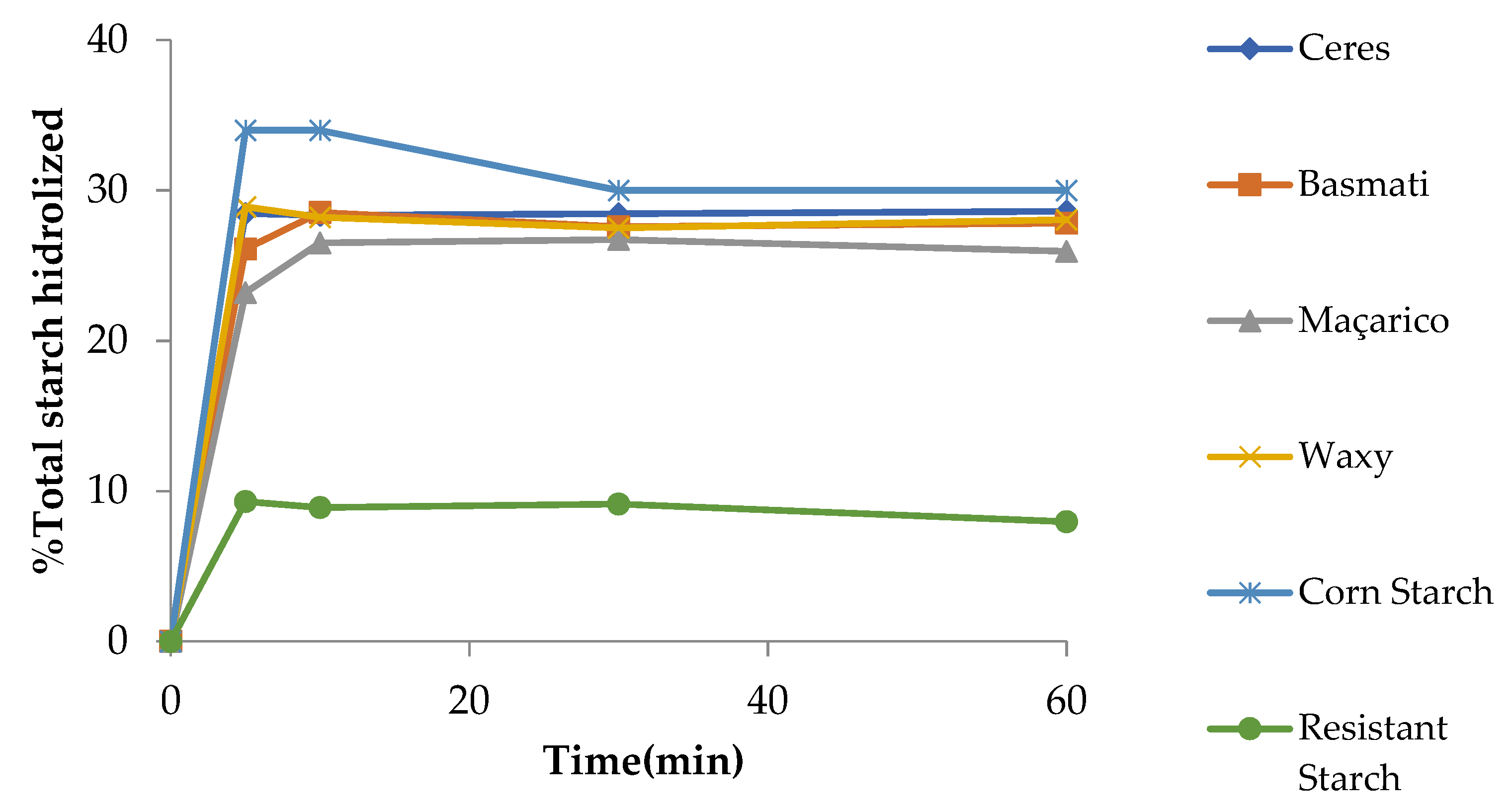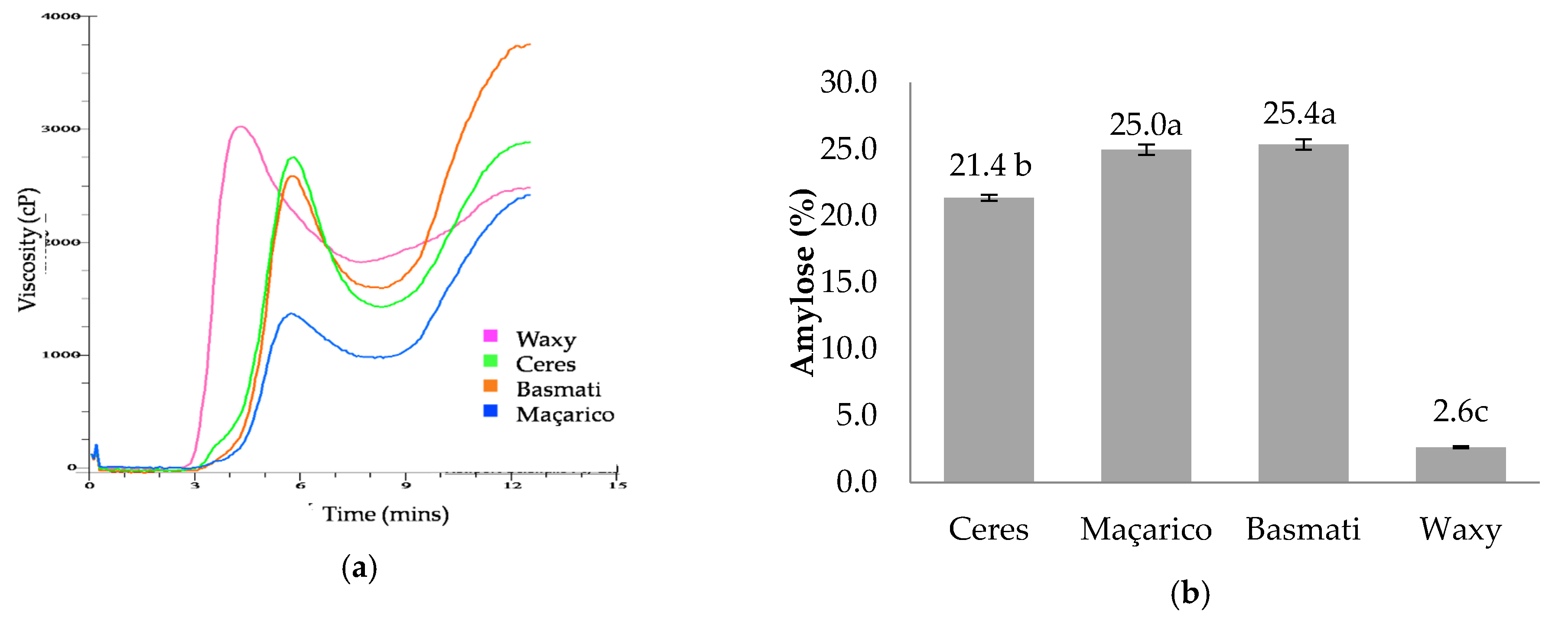Evaluation of Starch Hydrolysis for Glycemic Index Prediction of Rice Varieties †
Abstract
:1. Introduction
2. Material and Methods
2.1. Samples
2.2. Amylose Content
2.3. Rapid Visco Analyzer (RVA) Measurement
2.4. In Vitro Kinetics of Starch Digestion
3. Results and Discussion
3.1. In Vitro Starch Hydrolysis Rate Compared with Corn Starches and Estimated GI
3.2. Variation in the GI of Rice Samples and Its Relation with Amylose Content
3.3. Variation in the GI of Rice Samples and Its Relation with Viscosity Profiles
4. Conclusions
Funding
Conflicts of Interest
References
- Hu, J.; La Vecchia, C.; Augustin, L.S.; Negri, E.; de Groh, M.; Morrison, H. Glycemic index, glycemic load and cancer risk. Ann. Oncol. 2013, 24, 245, 251. [Google Scholar] [CrossRef] [PubMed]
- Thilakavathy, S.; Pandeeswari, N.K. The glycemic index—A science based diet. Int. J. Pharm. Med. Biol. Sci. 2012, 1, 259–265. [Google Scholar]
- ISO 26642:2010. Food Products—Determination of the Glycaemic Index (GI) and Recommendation for Food Classification; International Organization of Standardization: Geneva, Switzerland, 2010. [Google Scholar]
- Anacleto, R.; Badoni, S.; Parween, S.; Butardo, V.M.; Misra, G.; Cuevas, R.P.; Kuhlmann, M.; Trinidad, T.P.; Mallilin, A.C.; Acuin, C.; et al. ntegrating a genome-wide association study with a large-scale transcriptome analysis to predict genetic regions influencing the glycaemic index and texture in rice. Plant Biotechnol. J. 2019, 17, 1261–1275. [Google Scholar] [CrossRef] [PubMed]
- Frei, M.; Siddhuraju, P.; Becker, K. Studies on the in vitro starch digestibility and the glycemic index of six different indigenous rice cultivars from the Philippines. Food Chem. 2003, 83, 395–402. [Google Scholar] [CrossRef]
- Jenkins, D.J.; Kendall, C.W.; Augustin, L.S.; Franceschi, S.; Hamidi, M.; Marchie, A. Glycemic index: Overview of implications in health and disease. Am. J. Clin. Nutr. 2002, 76, 266–273. [Google Scholar] [CrossRef]
- Chang, U.J.; Hong, Y.H.; Jung, E.Y.; Suh, H.J. Overview of rice and health: Rice and the Glycemic Index. In Wheat and Rice in Disease Prevention and Health, 1 st ed.; Publisher: Elsevier: London, 2014; Volume 27, pp. 357–363. [Google Scholar]
- Kumar, A.; Sahoo, U.; Baisakha, B.; Okpani, O.A.; Ngangkham, U.; Parameswaran, C.; Basak, N.; Kumar, G.; Sharma, S.G. Resistant starch could be decisive in determining the glycemic index of rice cultivars. J. Cereal Sci. 2018, 79, 348–353. [Google Scholar] [CrossRef]
- Hu, P.; Zhao, H.; Duan, Z.; Linlin, Z.; Wu, D. Starch digestibility and the estimated glycemic score of different types of rice differing in amylose contents. J. Cereal Sci. 2004, 40, 231, 237. [Google Scholar] [CrossRef]
- Wani, I.; Sogi, D.; Wani, A.; Gill, B. Physico-chemical and functional properties of flours from Indian kidney bean (Phaseolus vulgaris L.) cultivars. LWT-Food Sci. Technol. 2013, 53, 278–284. [Google Scholar] [CrossRef]
- Chiu, C.J.; Liu, S.; Willett, W.C.; Wolever, T. Informing food choices and health outcomes by use of the dietary glycemic index. Nutr. Rev. 2011, 69, 231–242. [Google Scholar] [CrossRef] [PubMed]
- Foster-Powell, K.; Holt, S.H.A.; Brand-Miller, J.C. International table of glycemic index and glycemic load values. Am. J. Clin. Nutr. 2002, 76, 5–56. [Google Scholar] [CrossRef] [PubMed]
- Jain, A.; Rao, S.M.; Sethi, S.; Ramesh, A.; Tiwari, S.; Mandal, S.K.; Singh, N.K.; Modi, N.; Bansal, V.; Kalaichelvani, C. Effect of cooking on amylose content of rice. Eur. J. Exp. Biol. 2012, 2, 385–388. [Google Scholar]
- Nugent, A. Health properties of resistant starch. Nutr. Bull. 2005, 30, 27–54. [Google Scholar] [CrossRef]
- ISO 6647-2:2015. Rice—Determination of Amylose Content—Part 2: Routine Method; International Organization of Standardization: Geneva, Switzerland, 2015. [Google Scholar]
- Goni, I.; Garcia-AIonso, A.; Saura-Calixto, F. A starch hydrolysis procedure to estimate glycemic index. Nutr. Res. 1997, 17, 427–437. [Google Scholar] [CrossRef]
- Deepa, G.; Singh, V.; Naidu, K.A. A comparative study on starch digestibility, glycemic index and resistant starch of pigmented (‘Njavara’ and ‘Jyothi’) and a non-pigmented (‘IR 64′) rice varieties. J. Food Sci. Technol. 2010, 47, 644–649. [Google Scholar] [CrossRef] [PubMed]


| Types | RVA Parameters | Estimated GI (%) | |||
|---|---|---|---|---|---|
| Peak | Trough | Breakdown | Final Viscosity | ||
| Ceres | 2750 b | 1428 c | 1322 a | 2892 b | 88.49 b |
| Basmati | 2589 c | 1592 b | 997 c | 3755 a | 86.65 c |
| Maçarico | 1368 d | 977 d | 391 d | 2422 d | 83.71 d |
| Waxy | 3025 a | 1819 a | 1206 b | 2488 c | 88.20 b |
| Resistant starch | 54.80 e | ||||
| Corn starch | 94.60 a | ||||
Publisher’s Note: MDPI stays neutral with regard to jurisdictional claims in published maps and institutional affiliations. |
© 2020 by the authors. Licensee MDPI, Basel, Switzerland. This article is an open access article distributed under the terms and conditions of the Creative Commons Attribution (CC BY) license (https://creativecommons.org/licenses/by/4.0/).
Share and Cite
Pereira, C.; Menezes, R.; Lourenço, V.; Serra, T.; Brites, C. Evaluation of Starch Hydrolysis for Glycemic Index Prediction of Rice Varieties. Proceedings 2021, 70, 101. https://doi.org/10.3390/foods_2020-07643
Pereira C, Menezes R, Lourenço V, Serra T, Brites C. Evaluation of Starch Hydrolysis for Glycemic Index Prediction of Rice Varieties. Proceedings. 2021; 70(1):101. https://doi.org/10.3390/foods_2020-07643
Chicago/Turabian StylePereira, Cristiana, Regina Menezes, Vanda Lourenço, Teresa Serra, and Carla Brites. 2021. "Evaluation of Starch Hydrolysis for Glycemic Index Prediction of Rice Varieties" Proceedings 70, no. 1: 101. https://doi.org/10.3390/foods_2020-07643
APA StylePereira, C., Menezes, R., Lourenço, V., Serra, T., & Brites, C. (2021). Evaluation of Starch Hydrolysis for Glycemic Index Prediction of Rice Varieties. Proceedings, 70(1), 101. https://doi.org/10.3390/foods_2020-07643







